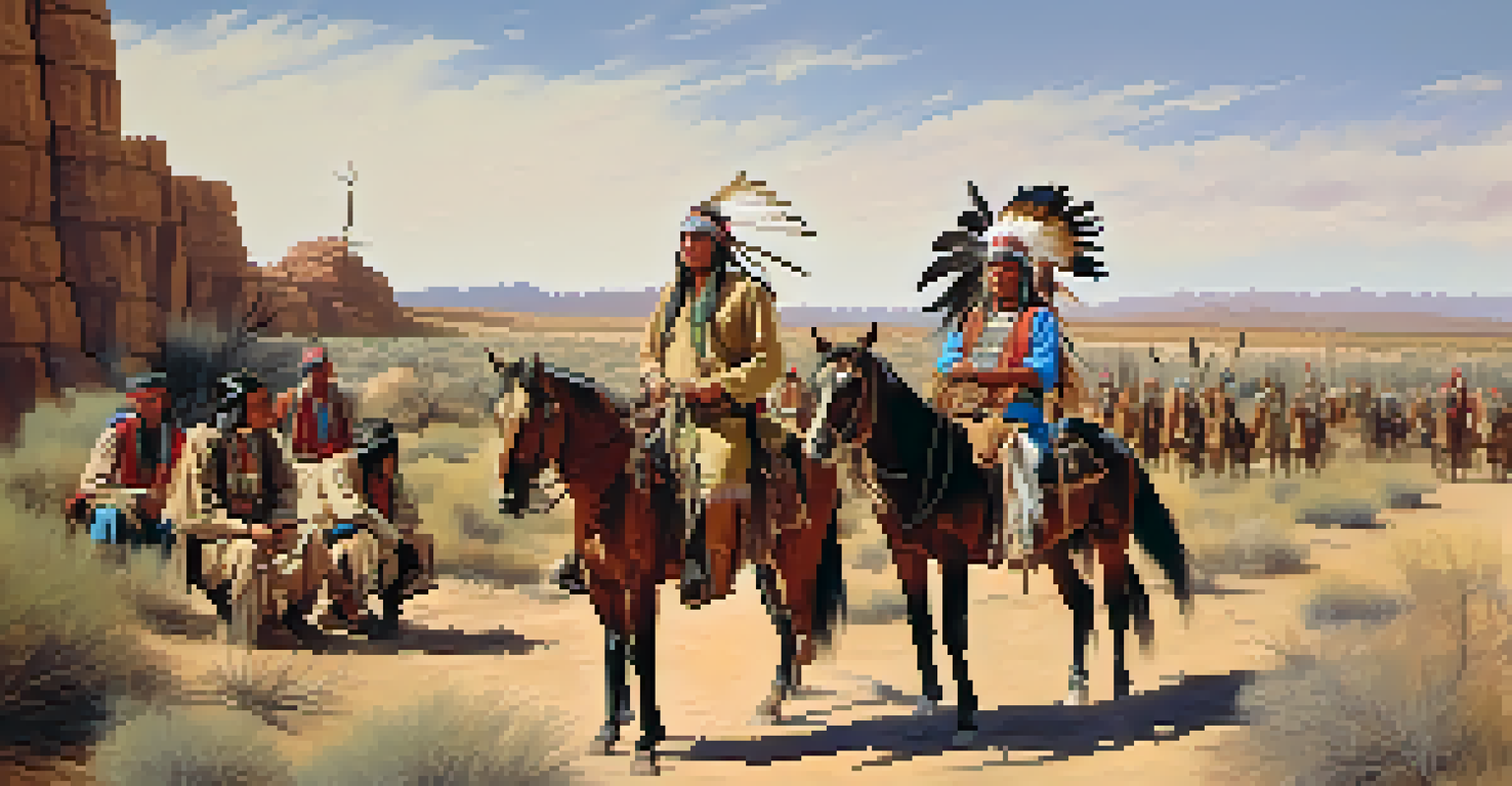The Role of Arizona in the Civil War: Forts and History

Introduction to Arizona's Civil War Significance
While Arizona may not be the first state that comes to mind when discussing the Civil War, its role was quite significant. The territory was a strategic location for both the Union and the Confederacy, influencing military movements and supply lines. Understanding Arizona's involvement gives us a broader view of the war's complexities beyond the battlefield.
The Civil War was a pivotal moment in American history that set the framework for a nation struggling to define itself.
During this period, Arizona was still a territory, not yet a state, which added another layer of complexity to its role. The population was diverse, comprising Native Americans, settlers, and Confederate sympathizers, each with distinct perspectives on the war. This mix of cultures and opinions created a unique environment that shaped Arizona's contributions to the conflict.
Additionally, the Civil War era marked a turning point in Arizona's history, impacting its development and future. The decisions made during this time influenced subsequent statehood and the region's growth, making it essential to examine Arizona's Civil War narrative in the broader context of American history.
Key Forts: Strategic Military Installations
Forts played a pivotal role in Arizona during the Civil War, serving as military outposts that secured the territory. Notable forts such as Fort Whipple and Fort Apache were established to protect settlers and maintain order amidst the chaos of conflict. These forts were strategically located to serve as hubs for troop movements and supply chains.

Fort Whipple, located near Prescott, was crucial for the Union efforts in the region. It not only provided shelter for soldiers but also acted as a base for operations against Confederate forces. The fort was instrumental in maintaining communication and logistics, which were vital for sustaining the Union’s presence in Arizona.
Arizona's Strategic Civil War Role
Arizona's geographical location was crucial for military operations, influencing both Union and Confederate strategies.
On the other hand, Fort Apache became a significant site for the protection of Native American populations and the enforcement of federal policies. The fort's role extended beyond military functions; it became a center for negotiations and interactions between the U.S. government and Indigenous tribes, highlighting the multifaceted nature of military forts during the war.
The Confederate Invasion of Arizona
In 1861, the Confederate States of America sought to expand their territory into Arizona, aiming to control its resources and strategic location. Their ambitions led to the establishment of the Confederate Territory of Arizona, which included parts of present-day Arizona and New Mexico. This move was driven by the desire to secure access to the Pacific Coast and vital trade routes.
In war, there are no unwounded soldiers.
The Confederate invasion was met with resistance from Union loyalists and Native American tribes. Battles such as the Battle of Picacho Pass highlighted the fierce confrontations that took place in the arid desert landscape. These skirmishes underscored the importance of Arizona as a battleground for control between the opposing forces.
Despite these efforts, the Confederacy struggled to maintain control over Arizona. The Union's determination and the challenging geography of the region played significant roles in thwarting Confederate ambitions. Ultimately, the conflict in Arizona reflected the broader struggles of the Civil War, where local allegiances and national interests often collided.
Native American Involvement in the Civil War
The Civil War had a profound impact on Native American tribes in Arizona, many of whom found themselves caught between the Union and Confederate forces. Some tribes allied with the Confederacy, hoping to gain autonomy and protect their lands, while others supported the Union, seeing it as a means to counter the encroachment of settlers. This division created complex relationships and shifting alliances.
For instance, the Apache and Navajo tribes had different responses to the war. The Apache, led by figures like Cochise, sought to resist both Union and Confederate forces, focusing on preserving their territory. In contrast, some Navajo groups engaged in negotiations with Union leaders, aiming to secure their interests amid the chaos of the war.
Diverse Native American Alliances
Native American tribes in Arizona navigated complex alliances during the Civil War, impacting their sovereignty and future relations with the U.S. government.
These alliances had lasting effects on Native American history in Arizona. The outcomes of the Civil War and subsequent policies influenced tribal sovereignty and land rights, shaping the relationship between Native Americans and the U.S. government for years to come. Understanding this involvement is crucial to grasping the full scope of Arizona's Civil War history.
Post-War Effects on Arizona's Development
The conclusion of the Civil War marked the beginning of a new chapter for Arizona, leading to significant changes in its social and economic landscape. The war disrupted established systems, but it also opened doors for development and growth. As the Union emerged victorious, the political landscape shifted, paving the way for Arizona's eventual statehood in 1912.
In the aftermath, the focus turned towards rebuilding and establishing infrastructure. The military forts that once served as battlegrounds transformed into centers of commerce and governance, facilitating the integration of Arizona into the broader national framework. This transition played a crucial role in shaping the territory’s future economy.
Additionally, the post-war period saw an influx of settlers drawn by the promise of land and opportunity. This migration led to the establishment of new communities and industries, further solidifying Arizona's place in the American West. The legacy of the Civil War remained palpable in the evolving identity of the territory, influencing its trajectory long after the conflict ended.
Cultural Legacy: Memory and Commemoration
Arizona's Civil War history is preserved through various cultural legacies, including monuments, museums, and reenactments. These commemorations serve to honor the sacrifices made during the war and educate future generations about this pivotal time in history. Sites like the Arizona Historical Society play a vital role in maintaining this collective memory.
Local communities often organize events that celebrate their heritage while remembering the complexities of the Civil War. These activities foster a sense of connection to the past and encourage dialogue about the impact of the war on today's society. By engaging with history, Arizonans are able to reflect on the lessons learned and the ongoing relevance of that period.
Post-War Growth and Development
The aftermath of the Civil War led to significant social and economic changes in Arizona, paving the way for statehood and new community developments.
Moreover, the narratives surrounding Arizona's role in the Civil War continue to evolve, influenced by new research and perspectives. As historians uncover more about the experiences of various groups, including Native Americans and settlers, the story becomes richer and more nuanced. This ongoing exploration ensures that Arizona's place in the Civil War is recognized and appreciated in the broader tapestry of American history.
Conclusion: Reflecting on Arizona's Civil War Journey
In conclusion, Arizona's role in the Civil War, though often overlooked, was significant and multifaceted. From its strategic forts to the involvement of diverse populations, the territory contributed to the broader narrative of the conflict. Recognizing these contributions helps us appreciate the complexities of the war and its lasting effects on the region.
The stories of struggle, alliance, and resilience that emerged during this time continue to shape Arizona's identity today. As we reflect on this history, it's essential to acknowledge the diverse voices that contributed to the journey, including those of Native Americans, settlers, and soldiers. Each perspective adds depth to our understanding of the past.

Ultimately, exploring Arizona's Civil War legacy invites us to consider how history informs our present. By engaging with these stories, we not only honor those who came before us but also gain insights into the ongoing challenges and triumphs that define our society. Arizona's journey through the Civil War is a testament to the enduring spirit of its people.